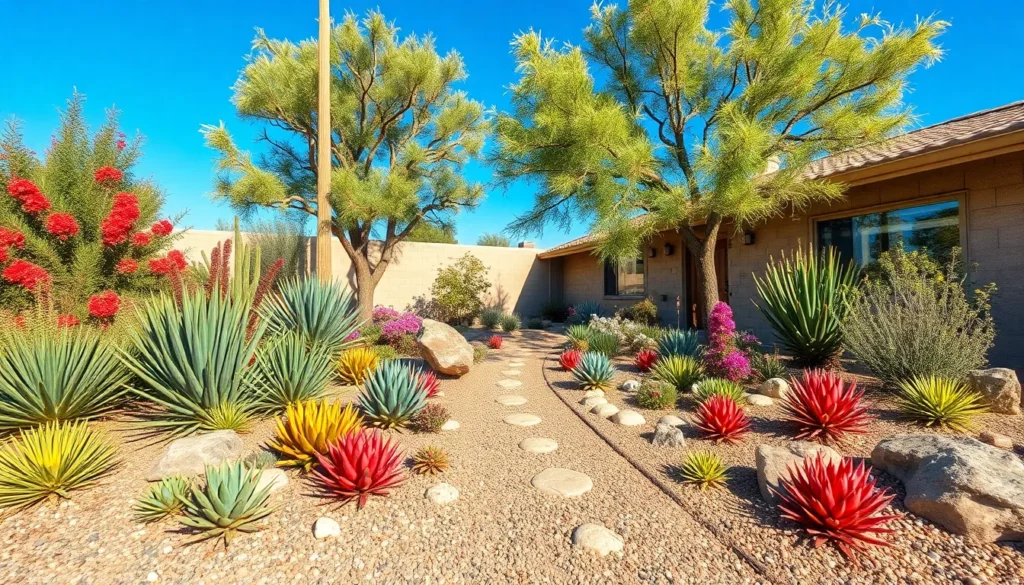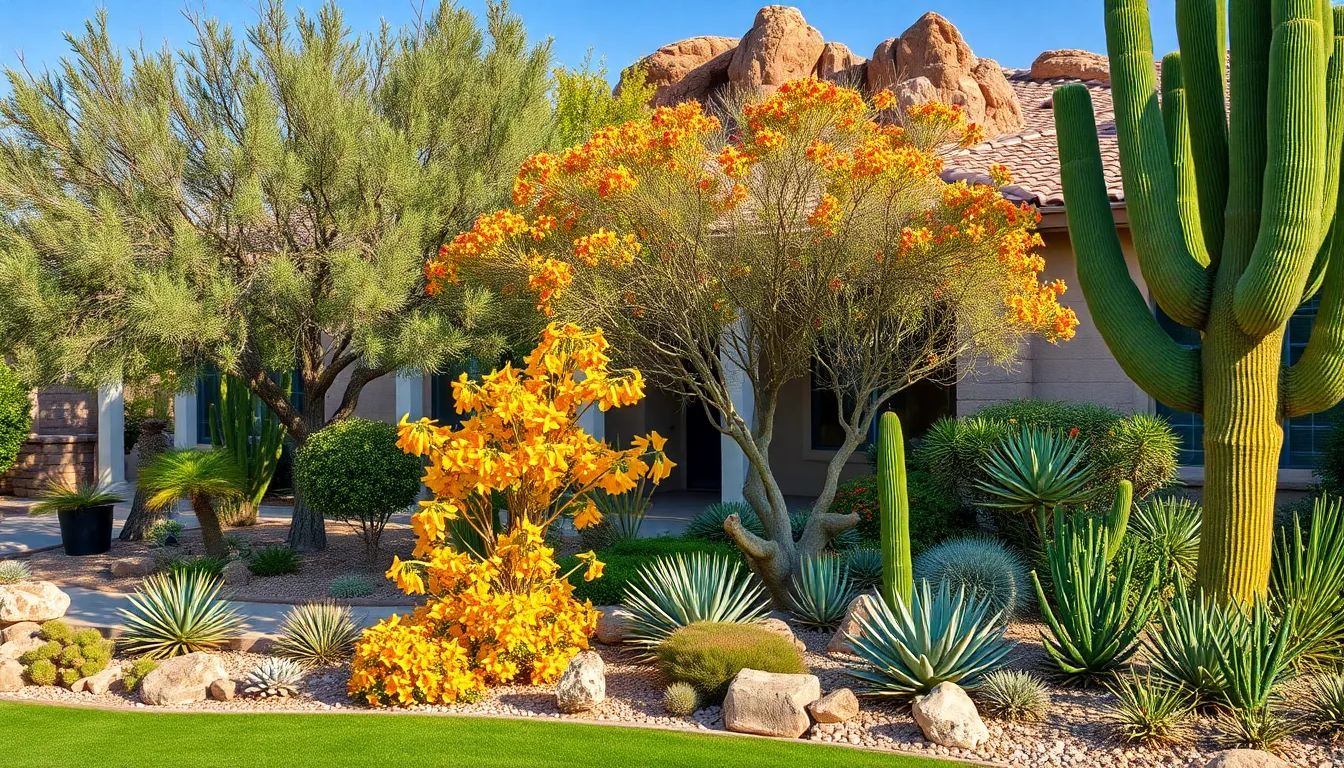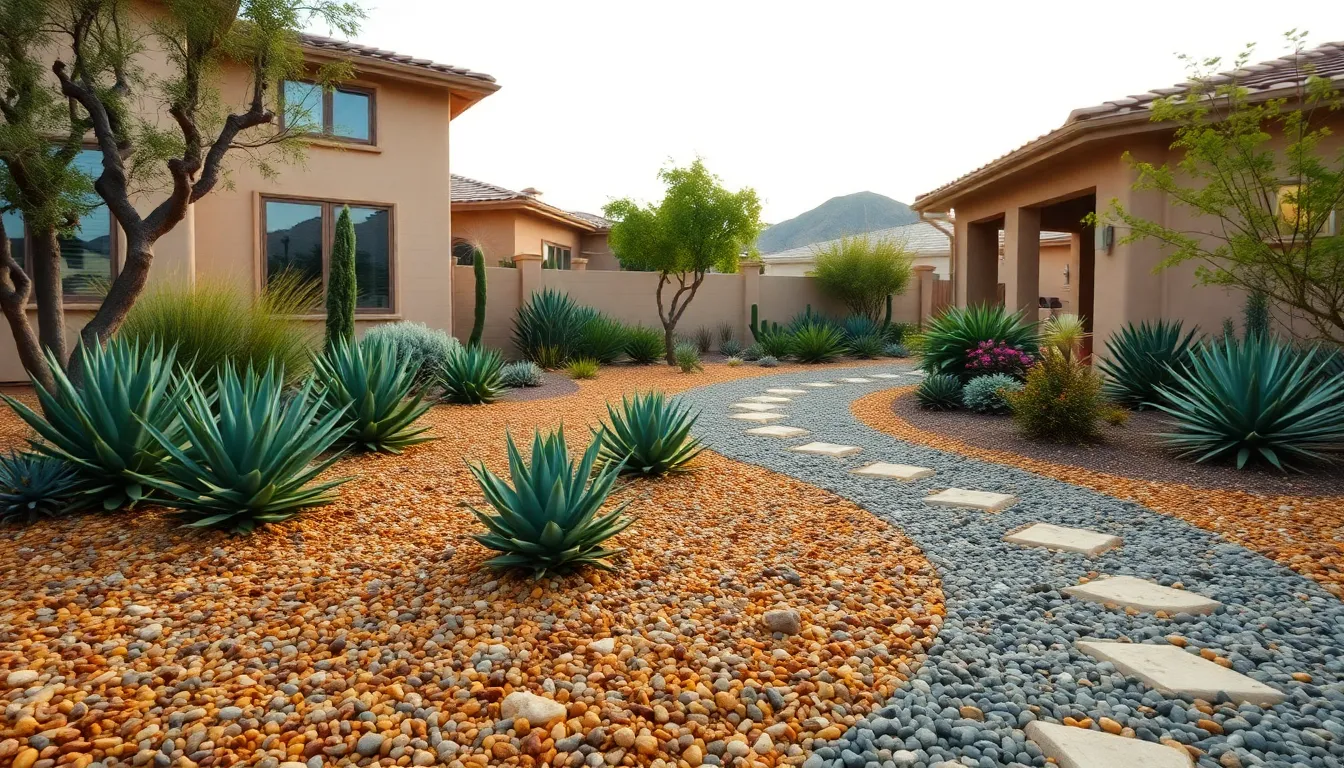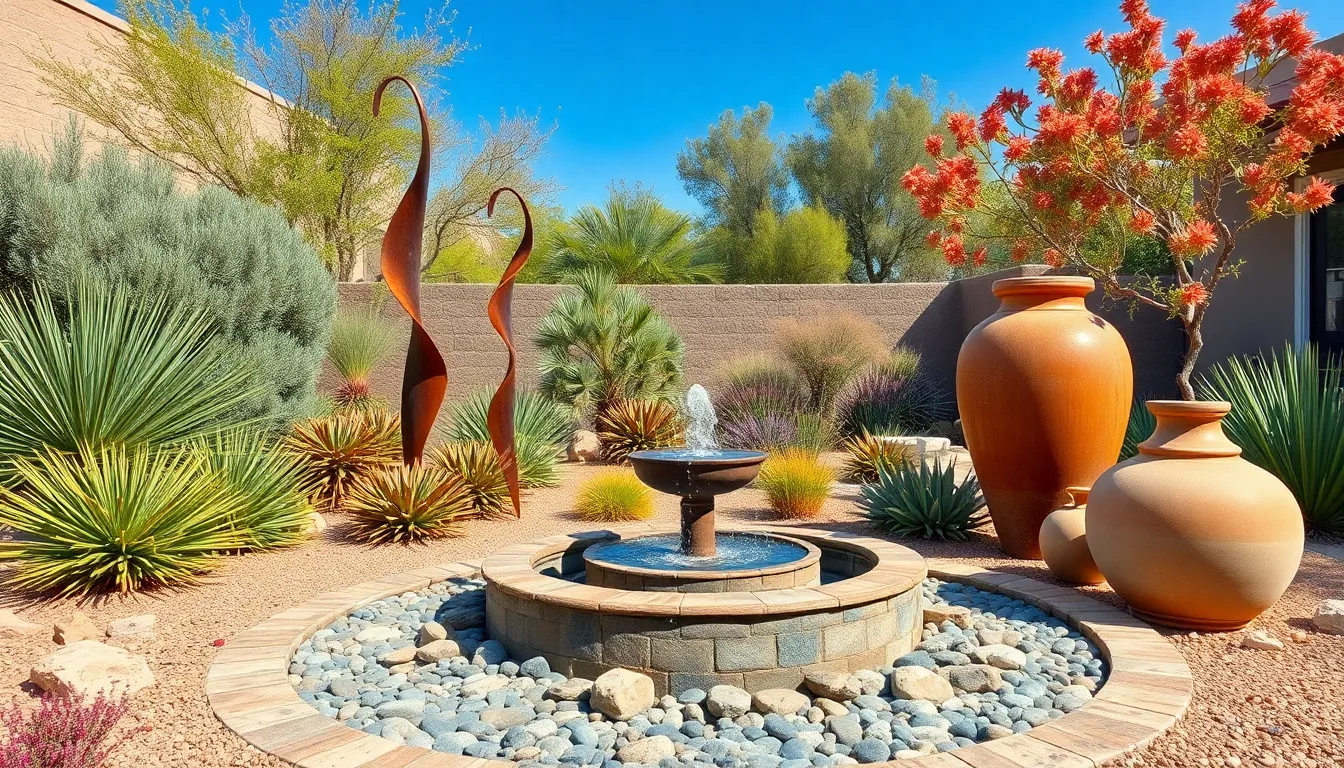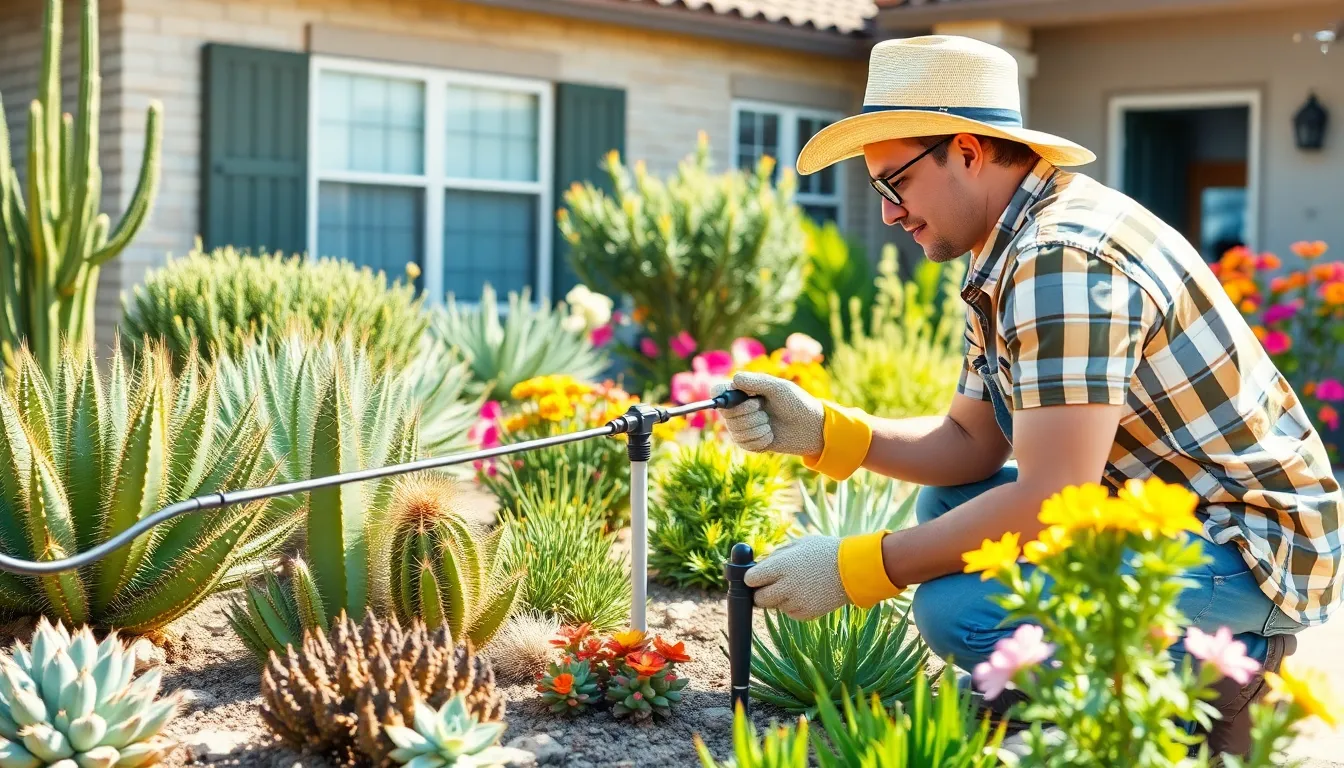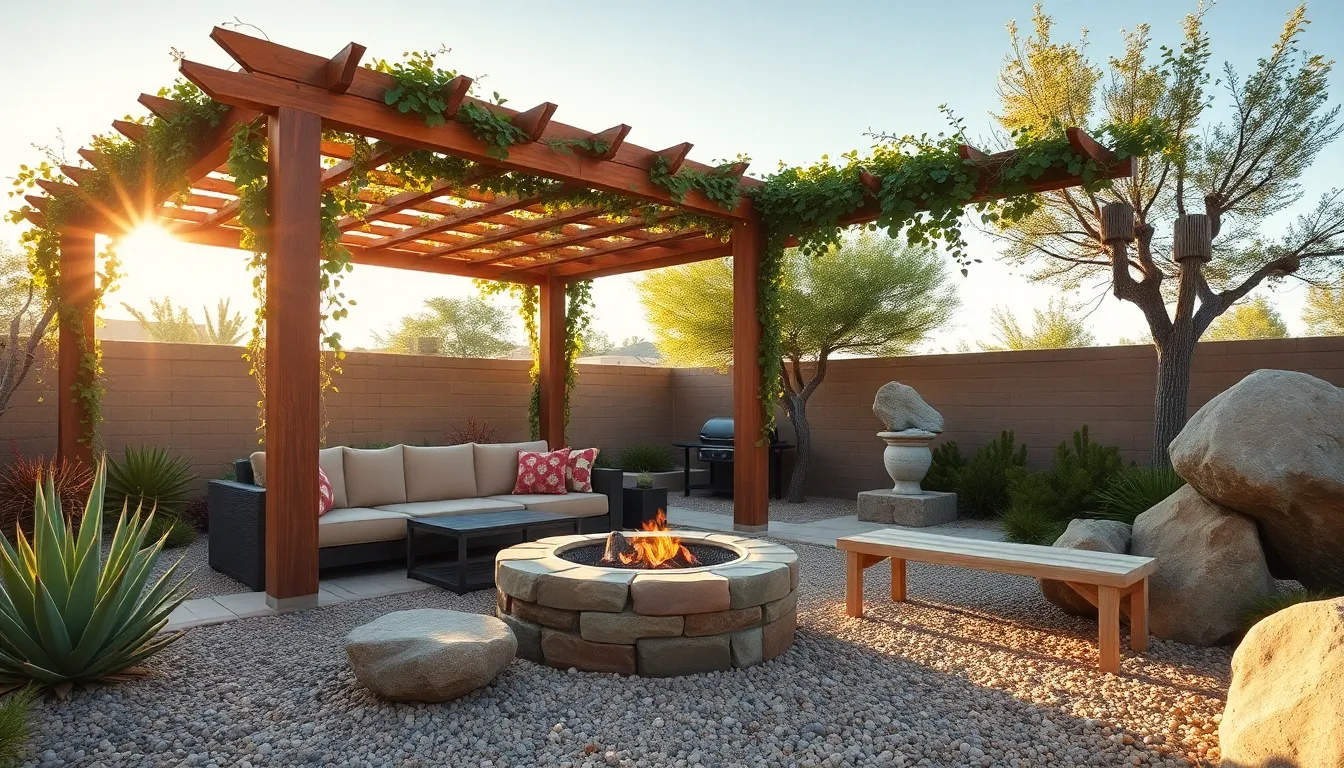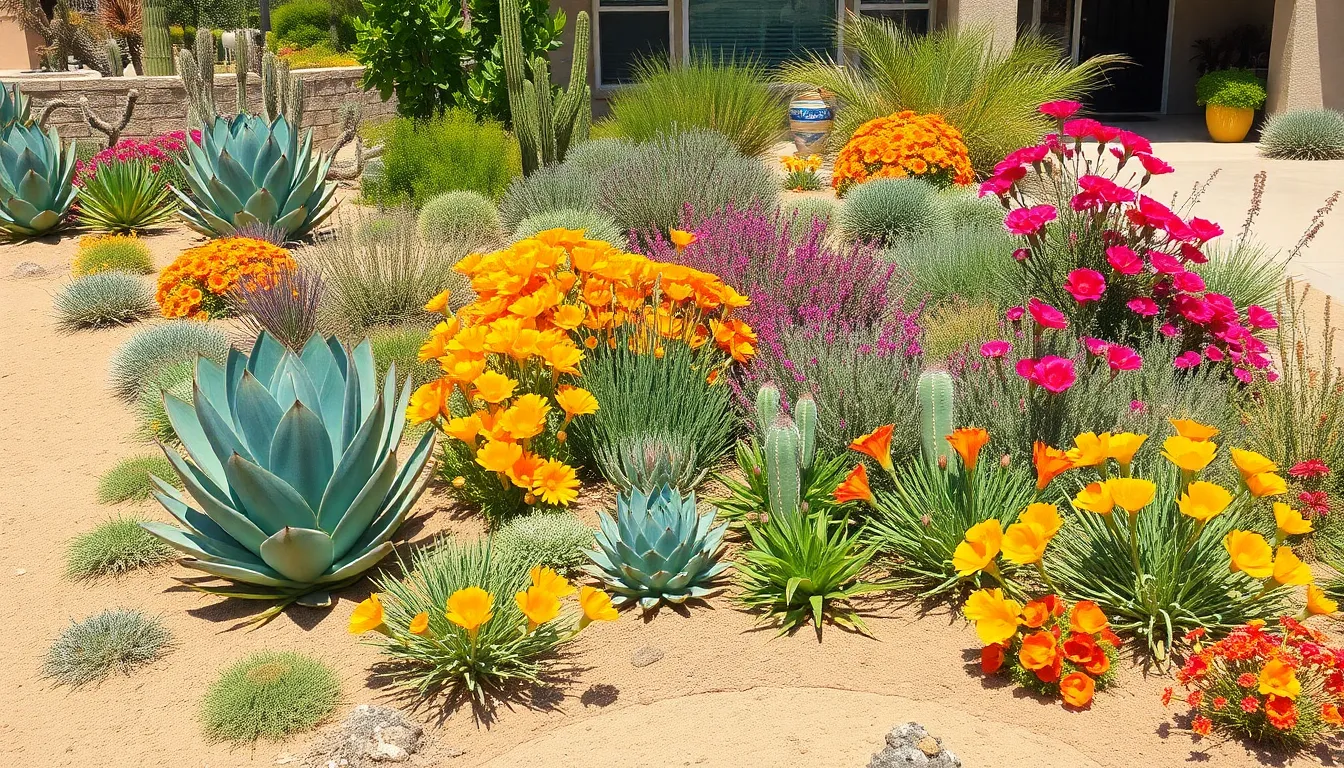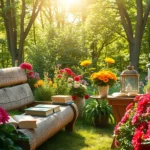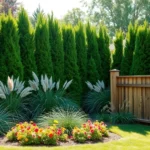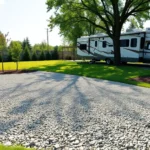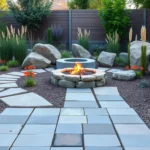Water bills skyrocketing? Tired of wrestling with thirsty grass that refuses to thrive in your arid climate? Desert landscaping transforms your front yard into a stunning low-maintenance oasis that actually loves the heat.
We’ve watched countless homeowners discover the beauty of xeriscaping – where dramatic succulents meet sculptural rocks and vibrant native plants create year-round visual interest. Desert landscaping isn’t just about survival; it’s about creating a striking entrance that stops neighbors in their tracks while slashing your water usage by up to 60%.
From modern minimalist designs featuring sleek agaves to rustic southwestern gardens bursting with colorful cacti, desert landscaping offers endless possibilities. We’ll show you how to design a front yard that thrives in challenging conditions while boosting your home’s curb appeal and property value.
Create a Stunning Succulent Garden Display
Succulents transform your front yard into a sculptural masterpiece that thrives in desert conditions. These water-wise plants offer endless possibilities for creating dramatic focal points while maintaining the low-maintenance benefits of desert landscaping.
Choose Low-Maintenance Agave and Aloe Varieties
Select agave species like Blue Glow or Artichoke Agave for their striking architectural forms and minimal care requirements. These plants store water in their thick leaves and can survive months without irrigation once established.
Plant aloe varieties such as Aloe arborescens or Aloe brevifolia to add vibrant colors ranging from blue-green to deep red. Both species produce stunning flower spikes in winter and spring while requiring watering only once every 2-3 weeks.
Position larger specimens like Agave americana or Century Plant as anchor points in your design. These giants can reach 6-8 feet wide and create dramatic shadows that enhance the desert aesthetic throughout the day.
Group smaller varieties including Agave parryi or Aloe vera in clusters of 3-5 plants to create visual impact without overwhelming the space. This approach mimics natural desert growth patterns while maximizing your garden’s visual appeal.
Design Geometric Patterns With Different Textures
Create triangular arrangements using three different succulent types with contrasting textures like smooth jade plants, spiky barrel cacti, and fuzzy lamb’s ear. This combination adds visual interest while maintaining the clean lines that complement modern home architecture.
Install rectangular planting beds filled with alternating rows of fine-textured sedums and bold-leafed echeveria. The contrast between delicate and substantial forms creates a sophisticated pattern that draws the eye across your industry.
Develop circular patterns by placing a tall centerpiece succulent surrounded by concentric rings of smaller plants with varying heights and textures. This design works particularly well with gravel mulch that defines each ring clearly.
Incorporate linear designs using ribbon-like varieties such as Senecio serpens or Agave geminiflora planted in straight lines or gentle curves. These create flowing movement while maintaining the structured appearance that defines contemporary desert gardens.
Add Height With Tall Century Plants
Position Agave americana specimens strategically to create vertical focal points that can reach 10-15 feet when flowering. These massive plants serve as natural sculptures that anchor your entire front yard design.
Plant Furcraea foetida for dramatic height without the extreme size of traditional century plants. This variety reaches 6-8 feet tall and produces spectacular flower spikes that can tower 20 feet above the garden.
Install Yucca rostrata or Beaked Yucca to add architectural height with their distinctive trunk-like stems topped by spherical crowns of blue-green leaves. These plants mature to 12 feet tall and create stunning silhouettes against your home’s facade.
Space tall specimens at least 8-10 feet apart to allow for their mature spread and prevent overcrowding. This spacing also creates opportunities to showcase smaller succulents in the foreground while maintaining clear sight lines to your home’s entrance.
Build Beautiful Rock Gardens and Xeriscapes
Rock gardens and xeriscapes transform your front yard into a drought-resistant masterpiece that requires minimal maintenance while maximizing visual impact. These water-wise landscaping techniques combine native desert materials with carefully selected plants to create stunning outdoor spaces that thrive in arid conditions.
Select Native Desert Stones and Boulders
Native desert stones provide the foundation for authentic-looking rock gardens that blend seamlessly with your local industry. We recommend choosing stones and boulders indigenous to your desert region to reduce material costs and create a cohesive natural appearance.
Larger boulders serve as dramatic focal points that anchor your entire design scheme. Position these substantial stones strategically throughout your yard to create visual weight and establish natural gathering areas. Smaller native rocks fill gaps between plantings and provide excellent drainage for your succulents and cacti.
Desert sandstone, granite, and volcanic rock offer distinct textures and colors that complement different plant selections. Each stone type weathers beautifully over time, developing natural patinas that enhance your industry’s authentic desert character.
Create Natural-Looking Stone Pathways
Natural stone pathways guide visitors through your desert industry while maintaining the organic feel of your rock garden. We suggest using irregularly shaped flagstones or flat desert rocks to create meandering paths that mimic natural formations.
Place stones with varying gaps between them to allow for small plantings or decorative gravel fill. This technique prevents the pathway from appearing too formal while providing opportunities to incorporate additional drought-tolerant plants like native wildflower mixes.
Gravel pathways offer another excellent option for desert landscapes, providing superior drainage and a softer walking surface. Choose decomposed granite or crushed stone that matches your regional desert colors for the most natural appearance.
Design Tiered Rock Formations
Tiered rock formations add dramatic vertical interest to flat front yards while creating microclimates for different plant varieties. We build these structures using progressively smaller stones from bottom to top, ensuring stability and natural visual flow.
Create planting pockets between each tier to showcase your favorite succulents and native shrubs like Desert Broom or Russian Sage. These elevated planting areas provide excellent drainage while creating distinct zones for different plant heights and textures.
Incorporate potted plants on various tier levels to add seasonal color and flexibility to your design. This approach allows you to experiment with different plant combinations without permanent installation, making it easier to refresh your industry’s appearance throughout the year.
Install Eye-Catching Desert Trees and Shrubs
Desert trees and shrubs form the backbone of stunning front yard landscapes while delivering exceptional water efficiency. These structural elements create visual anchors that complement your rock gardens and succulent displays.
Plant Drought-Tolerant Mesquite Trees
Mesquite trees offer unmatched durability in arid climates while providing essential shade and structure to desert landscapes. Their feathery foliage creates beautiful texture contrasts against the geometric patterns of your succulent arrangements.
We recommend planting mesquites as focal points near seating areas where their cooling shade becomes most valuable. Their robust root systems excel at stabilizing sandy soils that often challenge other tree varieties. Wildlife benefits from these native trees as they provide crucial habitat and food sources for desert birds and small mammals.
Mature mesquites require minimal irrigation once established, making them perfect companions to your existing rock garden features. Their deep taproots access groundwater that surface-rooted plants can’t reach.
Add Colorful Desert Willow for Seasonal Interest
Desert willow trees bring vibrant trumpet-shaped flowers that create stunning seasonal displays throughout summer months. Chilopsis linearis produces blooms in shades of pink, purple, and white that complement the muted tones of desert stones beautifully.
We love how their slender leaves and graceful weeping form add movement to static rock formations. These trees thrive with minimal water while delivering maximum visual impact during peak growing seasons. Their attractive bark texture provides year-round interest even when flowers aren’t present.
Plant desert willows in groups of three or five for dramatic effect near your home’s entrance. Their moderate size makes them ideal for smaller front yards where larger trees might overwhelm the space.
Include Native Palo Verde for Year-Round Structure
Palo verde trees deliver unique architectural presence with their distinctive green bark and bright yellow spring blooms. Their small leaves minimize water loss through evaporation while the photosynthetic green bark continues producing energy even during drought periods.
We position these trees strategically to frame property boundaries and create natural privacy screens. Their upright growth habit contrasts beautifully with the horizontal lines of your tiered rock formations. Native palo verdes establish quickly in desert soils and require virtually no supplemental watering after their first year.
These trees work exceptionally well as specimen plants in gravel mulch beds surrounded by carefully placed boulders. Their year-round green color provides consistent backdrop for seasonal wildflower displays and colorful succulent groupings.
Design Functional Gravel and Mulch Areas
Building on our desert industry foundation, we now turn to the practical elements that make desert yards both beautiful and sustainable. Gravel and mulch areas serve as the backbone of water-wise landscaping, providing essential functions like water conservation and soil erosion control while creating stunning visual appeal.
Choose Decorative Decomposed Granite
Decomposed granite stands out as one of the most versatile materials for desert front yards due to its fine texture and natural color palette. We find that DG creates exceptionally stable walking surfaces that withstand heavy foot traffic while maintaining an elegant appearance year-round. The material’s natural colors blend seamlessly with desert surroundings, making it perfect for defining plant beds and creating smooth transitions between different industry zones.
Installation proves remarkably straightforward, as decomposed granite compacts naturally when wetted and rolled. We recommend using DG to create defined pathways that connect various garden areas, establishing clear circulation patterns throughout your industry. The material works particularly well around specimen plants like agave and desert trees, where it provides a clean, finished look that highlights your plantings.
Create Colorful Gravel Patterns and Borders
Colorful gravel transforms ordinary desert landscapes into ever-changing works of art through strategic pattern creation and border definition. We’ve found that combining different gravel shades creates striking visual contrast that complements native desert plants and existing stone elements. Red decomposed granite paired with gray river rock, for example, establishes bold geometric patterns that enhance your yard’s architectural features.
Mixing gravel sizes adds another layer of visual interest to your design scheme. We suggest using larger stones as accent pieces within beds of finer gravel, creating natural-looking compositions that mimic desert washes. Border applications work especially well along walkways and property lines, where contrasting gravel colors can define spaces and guide the eye through your industry.
Pattern creation becomes even more impactful when you consider the existing elements in your design. We recommend echoing the colors found in your home’s exterior or nearby hardscaping to create a cohesive look that ties everything together.
Use Organic Mulch for Plant Health
Organic mulch provides essential benefits that synthetic alternatives simply cannot match, particularly for desert plant health and soil improvement. We use bark chips and wood mulch around our desert plantings because they gradually decompose and add valuable nutrients to the soil structure. This natural process creates a healthier growing environment for succulents, native shrubs, and desert trees.
Moisture retention becomes critical in desert climates, and organic mulch excels at keeping soil hydrated longer between irrigation cycles. We’ve observed that plants surrounded by organic mulch require significantly less supplemental watering than those growing in bare soil. The mulch layer acts as insulation, protecting plant roots from extreme heat during summer months and temperature fluctuations throughout the year.
Weed suppression ranks as another major advantage of organic mulch applications. We find that a 2-3 inch layer effectively prevents most weeds from establishing, reducing maintenance requirements and competition for water resources. The natural appearance of organic mulch also complements desert plantings better than synthetic alternatives, creating a more authentic desert industry aesthetic.
Incorporate Water-Wise Ornamental Features
Building on our drought-resistant foundation, we can elevate our desert industry with ornamental features that require minimal water while maximizing visual impact. These decorative elements transform functional xeriscaping into stunning outdoor art that celebrates the desert aesthetic.
Install Solar-Powered Desert Fountains
Solar-powered fountains bring ever-changing movement and tranquil sounds to our desert industry without increasing water or electricity costs. These sustainable water features use renewable energy to create soothing ambiance while staying true to water-wise principles. We’ll find that the gentle sound of flowing water makes our front yard feel like a peaceful retreat.
Positioning these fountains strategically creates focal points that draw the eye while complementing our existing desert plants. The solar panels eliminate the need for electrical connections, making installation simpler and more environmentally friendly. Modern solar fountain designs range from contemporary geometric styles to rustic earthenware vessels that blend seamlessly with desert surroundings.
Add Artistic Metal Sculptures and Pottery
Metal sculptures provide durable focal points that withstand harsh sun exposure while adding artistic flair to our industry design. These bold forms create striking contrasts against the natural textures of cacti and ornamental grasses. We can choose from contemporary abstract pieces or traditional southwestern motifs that reinforce our desert theme.
Pottery in varied shapes, sizes, and earthy tones adds texture and serves as both decorative elements and functional plant containers. Terra cotta and ceramic vessels work particularly well, offering warm colors that harmonize with desert plants. Grouping pottery pieces of different heights creates visual interest while providing versatile options for seasonal plant displays.
The combination of metal and ceramic elements introduces human artistry into our natural industry, creating conversation pieces that enhance curb appeal year-round.
Create Focal Points With Large Ceramic Vessels
Large ceramic vessels act as striking anchors that ground our industry composition and provide elegant accents throughout the growing season. We can position these vessels strategically to define seating areas, mark garden bed transitions, or create dramatic entryways. Their substantial size commands attention while maintaining the sophisticated simplicity that defines successful desert landscaping.
Glazed ceramic vessels in earth tones complement the warm colors of desert blooms, while their smooth surfaces provide visual relief from the textured foliage of native plants. These containers work beautifully as standalone sculptural elements or as sophisticated planters for seasonal displays. We’ll discover that larger vessels create more impact with less maintenance than multiple smaller decorative pieces.
The key lies in selecting vessels with colors and finishes that echo our existing hardscape materials, creating a cohesive design that feels intentional rather than scattered.
Plan Efficient Drip Irrigation Systems
Building on our water wise ornamental features, we need to establish an irrigation backbone that delivers precise water amounts directly to plant roots while minimizing evaporation and runoff. Strategic drip irrigation planning ensures each plant receives optimal moisture without waste.
Design Zone-Based Watering Answers
Group similar water needs plants together to create efficient irrigation zones that maximize water conservation. Cacti and succulents require minimal water and should occupy separate zones from flowering shrubs that need more frequent irrigation. Desert broom and Russian sage thrive with moderate watering schedules, making them ideal companions in shared zones.
Create separate drip lines for different plant categories to avoid overwatering drought tolerant species. Native wildflowers like coral plant and Mexican gold poppies need seasonal adjustments that differ from year round grasses and ornamental plants. We can establish dedicated zones for high, medium, and low water requirement plants to optimize irrigation efficiency.
Match emitter flow rates to exact plant root zones for precise water delivery. Large desert trees need higher flow emitters placed farther from trunks, while shallow rooted succulents benefit from low flow emitters positioned close to plant bases. This targeted approach prevents water waste and promotes healthier plant development.
Install Timer-Controlled Emitter Systems
Automate irrigation schedules with programmable timers that deliver water during early morning or late evening hours when evaporation rates are lowest. Morning watering between 4 AM and 6 AM allows plants to absorb moisture before intense heat arrives, while evening sessions after 8 PM provide overnight hydration without immediate evaporation loss.
Program multiple daily cycles for newly planted desert species that need establishment watering before transitioning to drought tolerant schedules. Short, frequent watering sessions help young roots develop properly, while mature plants can shift to longer, less frequent irrigation cycles. Timer controls eliminate the guesswork and ensure consistent watering regardless of our daily schedules.
Set seasonal adjustments that reduce watering frequency during cooler months and increase moisture delivery during peak summer heat. Winter irrigation can decrease by 50% or more, while summer months may require daily watering for sensitive plants. Programmable timers accommodate these seasonal variations automatically.
Add Moisture Sensors for Smart Watering
Install soil moisture sensors at various depths and locations to monitor real time moisture levels throughout different plant zones. These sensors prevent both overwatering and underwatering by providing accurate soil condition data that triggers irrigation only when needed. We can position sensors near representative plants in each zone for comprehensive monitoring.
Connect sensors to irrigation controllers that automatically adjust watering schedules based on actual soil moisture rather than predetermined timers. Smart systems pause irrigation during rainy periods and extend watering during drought conditions, ensuring plants receive appropriate moisture while conserving water resources.
Monitor root zone moisture at depths where different plants access water to optimize irrigation timing and duration. Shallow rooted succulents need surface level monitoring, while deeper rooted desert trees require sensors placed 12 to 18 inches below ground. This multi level approach ensures all plants receive adequate moisture at their preferred root depths.
Add Outdoor Living Spaces With Desert Flair
Building on our foundation of water-wise plants and efficient irrigation, we can transform our desert front yards into complete outdoor living environments. These functional spaces blend seamlessly with native desert aesthetics while providing comfortable areas for relaxation and entertainment.
Create Shaded Seating Areas With Pergolas
Pergolas provide essential relief from intense desert heat while maintaining an open, airy atmosphere. Position these structures strategically near heavily textured desert plants like agave or yucca to create authentic desert focal points. We recommend combining pergolas with native vines such as desert broom or grape vines that can withstand arid conditions.
Native desert plants surrounding pergola areas offer natural cooling effects through transpiration and visual appeal. Consider placing comfortable, weather-resistant seating beneath these structures to create inviting garden nooks. Materials like cedar or metal work exceptionally well in desert climates, requiring minimal maintenance while providing lasting durability.
Strategic placement near existing desert plantings maximizes both shade coverage and visual integration with your industry design. We’ve found that pergolas work particularly well when positioned to frame views of dramatic desert plants or rock formations.
Design Fire Pit Gathering Spaces
Fire pits create compelling focal points that extend outdoor enjoyment into cooler desert evenings. Stone or concrete fire pit designs complement the natural desert aesthetic while providing durability against temperature fluctuations. Surround these gathering spaces with comfortable seating made from weather-resistant materials like powder-coated metal or treated wood.
Native desert plants and gravel ground cover around fire areas maintain the low maintenance theme while improving visual appeal. Decomposed granite works particularly well as base material, providing stable footing and excellent drainage. We suggest incorporating larger boulders as natural seating or design elements that echo the surrounding industry.
Safety considerations include maintaining adequate clearance from plants and structures while ensuring proper ventilation. Position fire pits away from overhanging branches and consider prevailing wind patterns when selecting locations.
Build Low Maintenance Outdoor Kitchens
Outdoor kitchens designed with desert-friendly materials withstand extreme heat and arid conditions with minimal upkeep. Stone and metal construction materials prove most effective, requiring less maintenance than traditional wood or composite options. Keep layouts simple and functional to reduce cleaning and maintenance requirements.
Xeriscaping principles around kitchen areas involve planting drought-tolerant native shrubs like desert broom or Russian sage for beauty without high water demands. These plants provide natural screening and softening effects while requiring minimal irrigation once established. We recommend positioning cooking areas to take advantage of natural shade from existing trees or structures.
Storage answers built into outdoor kitchens should account for desert conditions, including temperature extremes and occasional dust storms. Covered storage compartments protect equipment and supplies while maintaining the clean, streamlined appearance that complements desert landscaping aesthetics.
Choose the Right Desert Plants for Your Climate Zone
Selecting plants suited to your exact desert climate zone ensures they’ll thrive with minimal care while complementing your outdoor living spaces. Native desert plants possess natural adaptations for heat, drought, and poor soil conditions that make them ideal choices for sustainable front yard designs.
Research Native Plants for Your Region
Native plants offer the perfect foundation for creating vibrant desert landscapes that require less water and maintenance than traditional alternatives. Coral plants (firecracker plants) provide brilliant red blooms that attract hummingbirds throughout the growing season. Mexican gold poppies create stunning orange carpets during spring months while requiring virtually no supplemental watering once established.
Desert mallow produces delicate papery flowers in shades of orange and red that bloom repeatedly throughout the year. Desert rose shrubs develop thick succulent stems and produce clusters of pink or white flowers that create dramatic focal points in xeriscaped areas. We recommend sourcing these plants as seeds from specialty suppliers that focus on heirloom and native varieties to ensure authentic genetic diversity.
Select Plants With Similar Water Requirements
Grouping plants with similar water needs together maximizes irrigation efficiency while creating cohesive design zones throughout your industry. This strategic placement helps conserve precious water resources by allowing us to target exact areas with appropriate moisture levels. Plants positioned close together naturally shade the soil surface which reduces evaporation rates during intense desert heat.
Sandy desert soils benefit significantly from this companion planting approach because moisture retention improves when root systems work together. Drought tolerant species like agave, prickly pear cactus, and desert sage thrive when planted in clusters that share similar watering schedules. We suggest creating distinct hydrozones that separate high water plants from extremely drought tolerant specimens to optimize resource allocation.
Consider Seasonal Color and Bloom Times
Incorporating native wildflowers and flowering shrubs that bloom at different times extends visual interest throughout multiple seasons while supporting local wildlife. Spring bloomers like desert lupines and ghost plants provide early season color when temperatures remain moderate. Summer flowering varieties such as fairy duster and chuparosa maintain vibrant displays during peak heat periods.
Fall blooming species like desert broom and brittlebush create golden autumn landscapes that transition beautifully into winter months. This strategic timing approach ensures continuous pollinator support while maintaining year round aesthetic appeal in your front yard design. We recommend planning bloom sequences that overlap slightly to avoid gaps in color coverage while maximizing ecological benefits for local bird and insect populations.
Conclusion
Desert landscaping transforms our front yards into stunning water-wise retreats that celebrate the natural beauty of arid environments. We’ve explored how strategic plant selection native species and efficient irrigation systems create sustainable outdoor spaces that thrive with minimal maintenance.
The combination of sculptural succulents dramatic rock formations and thoughtful hardscaping elements proves that eco-friendly doesn’t mean sacrificing style. These design principles help us build landscapes that enhance our property values while dramatically reducing water consumption and maintenance demands.
By embracing desert landscaping we’re not just creating beautiful outdoor spaces – we’re making smart long-term investments in our homes and environment. Start with one area of your front yard and gradually expand your desert oasis as you discover the rewards of this sustainable approach to landscaping.
Frequently Asked Questions
What is desert landscaping and why should I consider it?
Desert landscaping, also known as xeriscaping, uses drought-tolerant plants, rocks, and minimal water to create beautiful outdoor spaces. It’s perfect for homeowners in arid climates who want to reduce water bills, eliminate lawn maintenance, and increase property value while creating visually striking curb appeal.
What are the best plants for desert landscaping?
The best desert plants include native succulents like agave and aloe, mesquite trees, desert willow, palo verde trees, coral plants, Mexican gold poppies, and desert mallow. These plants thrive with minimal water, require little maintenance, and provide year-round visual interest while supporting local wildlife.
How much water can I save with desert landscaping?
Desert landscaping can significantly reduce water usage by 50-80% compared to traditional grass lawns. By using native drought-tolerant plants and efficient drip irrigation systems, homeowners can dramatically lower their water bills while maintaining a beautiful landscape even during drought conditions.
What irrigation system works best for desert gardens?
Drip irrigation systems are the most efficient choice for desert landscaping. They deliver water directly to plant roots, reducing evaporation and waste. Group plants by water needs, use moisture sensors to monitor soil conditions, and consider timer systems to optimize watering schedules.
Can I create different design styles with desert landscaping?
Yes! Desert landscaping offers versatile design options including modern minimalist styles with geometric patterns, rustic southwestern themes, and contemporary looks. You can incorporate contrasting textures, various heights, colorful plants, decorative rocks, and artistic elements to match your preferred aesthetic.
How do I maintain a desert landscape?
Desert landscapes are naturally low-maintenance. Focus on proper plant placement, use organic mulch for soil health, group plants with similar water needs, and choose native species. Regular but infrequent deep watering, occasional pruning, and seasonal color planning will keep your landscape thriving year-round.
What hardscape elements work well in desert yards?
Effective hardscape elements include native desert stones and boulders, gravel pathways, decorative rock gardens, pergolas for shade, fire pits for entertainment, and water-wise features like solar fountains. These elements add structure, functionality, and visual interest while requiring minimal maintenance.
Is desert landscaping suitable for outdoor entertaining?
Absolutely! Desert landscapes can include shaded seating areas with pergolas, fire pits for evening gatherings, and outdoor kitchens using desert-friendly materials. These spaces extend outdoor living while maintaining the water-efficient and low-maintenance benefits of xeriscaping principles.

